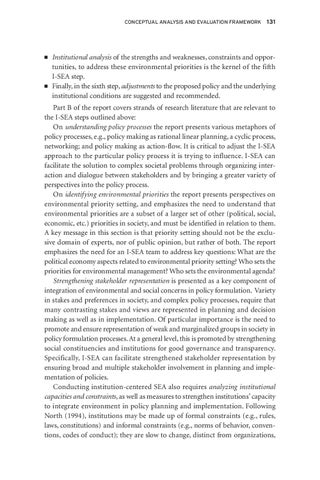CONCEPTUAL ANALYSIS AND EVALUATION FRAMEWORK
â–
â–
131
Institutional analysis of the strengths and weaknesses, constraints and opportunities, to address these environmental priorities is the kernel of the fifth I-SEA step. Finally, in the sixth step, adjustments to the proposed policy and the underlying institutional conditions are suggested and recommended.
Part B of the report covers strands of research literature that are relevant to the I-SEA steps outlined above: On understanding policy processes the report presents various metaphors of policy processes, e.g., policy making as rational linear planning, a cyclic process, networking; and policy making as action-flow. It is critical to adjust the I-SEA approach to the particular policy process it is trying to influence. I-SEA can facilitate the solution to complex societal problems through organizing interaction and dialogue between stakeholders and by bringing a greater variety of perspectives into the policy process. On identifying environmental priorities the report presents perspectives on environmental priority setting, and emphasizes the need to understand that environmental priorities are a subset of a larger set of other (political, social, economic, etc.) priorities in society, and must be identified in relation to them. A key message in this section is that priority setting should not be the exclusive domain of experts, nor of public opinion, but rather of both. The report emphasizes the need for an I-SEA team to address key questions: What are the political economy aspects related to environmental priority setting? Who sets the priorities for environmental management? Who sets the environmental agenda? Strengthening stakeholder representation is presented as a key component of integration of environmental and social concerns in policy formulation. Variety in stakes and preferences in society, and complex policy processes, require that many contrasting stakes and views are represented in planning and decision making as well as in implementation. Of particular importance is the need to promote and ensure representation of weak and marginalized groups in society in policy formulation processes. At a general level, this is promoted by strengthening social constituencies and institutions for good governance and transparency. Specifically, I-SEA can facilitate strengthened stakeholder representation by ensuring broad and multiple stakeholder involvement in planning and implementation of policies. Conducting institution-centered SEA also requires analyzing institutional capacities and constraints, as well as measures to strengthen institutions’ capacity to integrate environment in policy planning and implementation. Following North (1994), institutions may be made up of formal constraints (e.g., rules, laws, constitutions) and informal constraints (e.g., norms of behavior, conventions, codes of conduct); they are slow to change, distinct from organizations,
